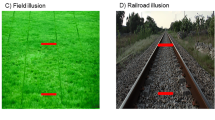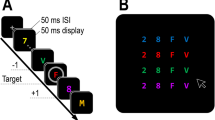Abstract
Perceptual multistability during ambiguous visual perception is an important clue to neural dynamics. We examined perceptual switching during ambiguous depth perception using a Necker cube stimulus, and also during binocular rivalry. Analysis of perceptual switching time series using variance–sample size analysis, spectral analysis and time series shuffling shows that switching times behave as a 1/f noise and possess very long range correlations. The long memory feature contrasts sharply with the traditional satiation models of multistability, where the memory is not incorporated, as well as with recently published models of multistability and neural processing, where memory is excluded. On the other hand, the long memory feature favors the concept of “dynamic core” or coalition of neurons, where neurons form transient coalitions. Perceptual switching then corresponds to replacement of one coalition of neurons by another. The inertia and memory measures the stability of a coalition: a strong and stable coalition has to be won over by another similarly strong and stable coalition, resulting in long switching times. The complicated transient dynamics of competing coalitions of neurons may be addressable using a combination of functional imaging, measurement of frequency-tagged magnetoencephalography and frequency-tagged encephalography, simultaneous recordings of groups of neurons in many areas of the brain, and concepts from statistical mechanics and nonlinear dynamics theory.







Similar content being viewed by others
References
Aks DJ, Sprott JC (2003) The role of depth and 1/f dynamics in perceiving reversible figures. Nonlinear Dynamics Psychol Life Sci 7:161–179
Attneave F (1971) Multistability in perception. Sci Am 225:63–71
Bak P (1996) How nature works: the science of self-organized criticality. Copernicus Press, New York
Bassingthwaighte JB, Liebovitch LS, West BJ (1994) Fractal physiology. Oxford University Press, New York
Billock VA (2000) Neural acclimation to 1/f spatial frequency spectra in natural images transduced by the human visual system. Phys D 137:379–391
Billock VA, de Guzman GC, Kelso JAS (2001) Fractal time and 1/f spectra in dynamic images and human vision. Phys D 148:136–146
Bisiach E, Ricci R, Lai E, De Tanti A, Inzaghi MG (1999) Unilateral neglect and disambiguation of the Necker cube. Brain 122:131–140
Blake R, Logothetis NK (2002) Visual competition. Nat Rev Neurosci 3:13–23
Borsellino A, Allazetta A, Bartolin B, Rinesi A, De Marco A (1972) Reversal time distribution in perception of visual ambiguous stimuli. Kybernetik 10:139–144
Chen YQ, Ding MZ, Kelso JAS (1997) Long memory processes (1/f(alpha) type) in human coordination. Phys Rev Lett 79:4501–4504
Collins JJ, De Luca CJ (1994) Random walking during quiet standing. Phys Rev Lett 73:764–767
Crick F, Koch C (2003) A framework for consciousness. Nat Neurosci 6:119–126
De Marco A, Penengo P, Trabucco A, Borsellino A, Carlini F, Riani M, Tuccio MT (1977) Stochastic-models and fluctuations in reversal time of ambiguous figures. Perception 6:645–656
Edelman GM, Tononi G (2000) A universe of consciousness. Basic Books, New York
Elbert T, Hommel J, Lutzenberger W (1985) The perception of Necker cube reversal interacts with the Bereitschaftspotential. Int J Psychophysiol 3:5–12
Feder J (1988) Fractals. Plenum, New York
Fox R, Herrmann J (1967) Stochastic properties of binocular rivalry alternations. Percept Psychophys 2:432–436
Gail A, Brinksmeyer HJ, Eckhorn R (2004) Perception-related modulations of local field potential power and coherence in primary visual cortex of awake monkey during binocular rivalry. Cereb Cortex 14:300–313
Gao JB, Cao YH, Lee JM (2003) Principal component analysis of 1/f noise. Phys Lett A 314:392–400
Gao JB, Hu J, Tung WW, Cao YH, Sarshar N, Roychowdhury VP (2006) Assessment of long range correlation in time series: How to avoid pitfalls. Phys Rev E 73:016117
Gilden DL, Thornton T, Mallon MW (1995) 1/f Noise in human cognition. Science 267:1837–1839
Harris CM, Hainline L, Abramov I, Lemerise E, Camenzuli C (1988) The distribution of fixation durations in infants and naive adults. Vis Res 28:419–432
Inui T, Tanaka S, Okada T, Nishizawa S, Katayama M, Konishi J (2000) Neural substrates for depth perception of the Necker cube; a functional magnetic resonance imaging study in human subjects. Neurosci Lett 282:145–148
Kaneko K, Tsuda I (2003) Chaotic itinerancy. Chaos 13:926–936
Kelso JAS (1995) Dynamic patterns: the self-organization of brain and behavior. MIT Press, Cambridge
Kelso JAS, Case P, Holroyd T, Horvath E, Raczaszek J, Tuller B, Ding M (1995) Multistability and metastability in perceptual and brain dynamics. In: Kruse P, Stadler M (eds) Ambiguity in mind and brain. Springer, Berlin Heidelberg New York, pp 159–184
Kleinschmidt A, Buchel C, Zeki S, Frackowiak RSJ (1998) Human brain activity during spontaneously reversing perception of ambiguous figures. Proc R Soc Lond B 265:2427–2433
Kreiman G, Fried I, Koch C (2002) Single-neuron correlates of subjective vision in the human medial temporal lobe. Proc Natl Acad Sci USA 99:8378–8383
Laing CR, Chow CC (2002) A spiking neuron model for binocular rivalry. J Comput Neurosci 12:39–53
van Leeuwen C, Steyvers M, Nooter M (1997) Stability and Intermittency in Large-Scale Coupled Oscillator Models for Perceptual Segmentation. J Math Psych 41:319–344
Lehky SR (1995) Binocular-rivalry is not chaotic. Proc R Soc Lond Ser B 259:71–76
Leland WE, Taqqu MS, Willinger W, Wilson DV (1994) On the self-similar nature of Ethernet traffic (Extended version). IEEE/ACM Trans Network 2:1–15
Leopold DA, Logothetis NK (1996) Activity changes in early visual cortex reflect monkeys’ percepts during binocular rivalry. Nature 379:549–553
Leopold DA, Logothetis NK (1999) Multistable phenomena: changing views in perception. Trends Cognit Sci 3:254–264
Leopold DA, Wilke M, Maier A, Logothetis NK (2002) Stable perception of visually ambiguous patterns. Nat Neurosci 5:605–609
Leopold DA, Murayama Y, Logothetis NK (2003) Very slow activity fluctuations in monkey visual cortex: Implications for functional brain imaging. Cereb Cortex 13:422–433
Li W, Kaneko K (1992) Long-range correlation and partial 1/f-Alpha spectrum in a noncoding DNA-sequence. Europhys Lett 17:655–660
Logothetis NK, Schall JD (1989) Neuronal correlates of subjective visual-perception. Science 245:761–763
Lumer ED, Friston KJ, Rees G (1998) Neural correlates of perceptual rivalry in the human brain. Science 280:1930–1934
von der Malsburg C (1999) The what and why of binding: the modeler’s perspective. Neuron 24:95–104
Mandelbrot BB (1982) The fractal geometry of nature. Freeman, San Francisco
Mandelbrot BB, Van Ness JW (1968) Fractional brownian motions, fractional noises and applications. SIAM Rev 10:422–437
Mandelbrot BB, Wallis JR (1969) Some long-run properties of geophysical records. Water Resources Res 5:321
Marr D (1980) Vision. MIT Press, Cambridge
Merk I, Schnakenberg J (2002) A stochastic model of multistable visual perception. Bio Cybern 86:111–116
Murata T, Matsui N, Miyauchi S, Kakita Y, Yanagida T (2003) Discrete stochastic process underlying perceptual rivalry. Neuroreport 14:1347–1352
Nakatani H, van Leeuwen C (2006) Transient synchrony of distant brain areas and perceptual switching in ambiguous figures. Biol Cybern (in press)
Nakatani H, van Leeuwen C (2005) Individual differences in perceptual switching rates; the role of occipital alpha and frontal theta band activity. Biol Cybern 93:343–354
Pavlovskaya M, Bonneh Y, Soroker N, Sagi D, Ring H (2001) Perceptual switching in patients with attention deficit. In: Presented at the 31st annual meeting of the Society for Neuroscience, San Diego, 10–15 November
Peng CK, Buldyrev SV, Goldberger AL, Havlin S, Sciortino F, Simons M, Stanley HE (1992) Long-range correlations in nucleotide-sequences. Nature 356:168–170
Peng CK, Buldyrev SV, Havlin S, Simons M, Stanley HE, Goldberger AL (1994) Mosaic organization of dna nucleotides. Phys Rev E 49:1685–1689
Pettigrew JD, Miller SM (1998) A ‘sticky’ interhemispheric switch in bipolsar disorder? Proc R Soc Lond B 265:2141–2148
Press WH (1978) Flicker noises in astronomy and elsewhere. Comments on Astrophys 7:103–119
Srinivasan R (2004) Internal and external neural synchronization during conscious perception Int J Bif Chaos 14:825–842
Steinbuchel N (1998) Temporal ranges of central nervous processing: clinical evidence. Exp Brain Res 123:220–233
Sterzer P, Russ MO, Preibisch C, Kleinschmidt A (2002) Neural correlates of spontaneous direction reversals in ambiguous apparent visual motion. Neuroimage 15:908–916
Suzuki S, Grabowecky M (2002) Evidence for perceptual “trapping” and adaptation in multistable binocular rivalry. Neuron 36:143–157
Tong F, Nakayama K, Vaughan JT, Kanwisher N (1998) Binocular rivalry and visual awareness in human extrastriate cortex. Neuron 21:753–759
Tononi G, Edelman GM (2000) Schizophrenia and the mechanisms of conscious integration. Brain Research Reviews 31:391–400
Tsuda I (2001) Toward an interpretation of dynamic neural activity in terms of chaotic dynamical systems. Behav Brain Sci 24:793–810
Voss RF (1985) Random fractal forgeries. In: Earnshaw RA (ed) Fundamental Algorithms for Computer Graphics. Springer, Berlin Heidelberg New York, pp 805–835
Voss RF (1992) Evolution of long-range fractal correlations and 1/f noise in DNA base sequences. Phys Rev Lett 68:3805–3808
Walker P (1975) Stochastic properties of binocular rivalry alternations. Percept Psychophys 18:467–473
Wornell GM (1996) Signal processing with fractals: a wavelet-based approach. Prentice Hall, Englewood Cliffs
Zhou YH, Gao JB, White KD, Merk I, Yao K (2004) Perceptual dominance time distributions in multistable visual perception. Biol Cybern 90:256–263
Author information
Authors and Affiliations
Corresponding author
Additional information
Communicated by Cees van Leeuwen
Rights and permissions
About this article
Cite this article
Gao, J.B., Billock, V.A., Merk, I. et al. Inertia and memory in ambiguous visual perception. Cogn Process 7, 105–112 (2006). https://doi.org/10.1007/s10339-006-0030-5
Received:
Revised:
Accepted:
Published:
Issue Date:
DOI: https://doi.org/10.1007/s10339-006-0030-5




